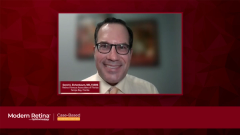
Patient Case #2: 81-Year-Old Male With nAMD
David A. Eichenbaum, MD, FASRS, reviews the case of a 81-year-old female with treatment experienced neovascular age-related macular degeneration (nAMD).
David A. Eichenbaum, MD, FASRS: This case is an example of a patient with a very aggressive neovascular macular degeneration. This is an 81-year-old man who’s come to Florida as a seasonal resident. He suffers from wet macular degeneration in both eyes. Even though his visual acuity is 20/200 bilaterally, he considers his left eye much better subjectively. His right eye has outer retinal atrophy, pigment atrophy, related to his macular degeneration. He says that eye was caught later in its course of progression. Even though we’re maintaining the anatomy in that eye, he’s hopeful that we’d be able to give him better visual acuity in his left eye. He’s so leaky and exudative that even while alternating aflibercept Q [every]-4-week with brolucizumab Q4 weeks, he continues to have significant exudative activity in his better eye. He is relatively healthy as an 81-year-old patient. He has controlled hypertension and hypercholesterolemia, and he is anticoagulated from having had a super vascular accident in 2015. He has not had any recent CNS [central nervous system] issues. He does remain on anticoagulation, and I worry about him having a hemorrhagic event in his better eye, partly because of his anticoagulation and the poor control of his neovascular process. If you look at his next slide, we’ll be able to see where he has ongoing neovascular activity despite Q4-week treatment with aflibercept and Q4-week treatment with brolucizumab alternating.
Here’s a horizontal cut looking at the patient on March 14, 4.5 weeks from a brolucizumab injection. Those of us who’ve been involved with the brolucizumab registration trials and/or have used it commercially know that brolucizumab is a potent drying agent. It’s really good at treating macular degeneration with regards to reducing fluid. Even with brolucizumab treatment just 4.5 weeks ago, this is how the patient looks in his better eye. His intraretinal fluid—if you look at the next slide, you’ll see in the vertical cut that he has subretinal fluid—he’s just poorly controlled.
The next slide will show you that the patient does have thickening. It’s the macular map on the next slide. I typically don’t look at these with as much of a critical eye as I do the B [brightness]-scan cross sections, but he clearly has a thick macula by any measure.
So what do we offer this patient? I offer the patient his first Vabysmo (faricimab-svoa) injection on that date in March. Coming back 4 weeks from this faricimab injection, we see that the patient has a dramatic improvement in his macular anatomy. What I’m finding in real-world faricimab use is that macular degenerative patients with exudation who are sensitive to angiopoietin-2 inhibition with bispecific faricimab have a rapid and dramatic response. I’m finding the diabetics have a less rapid and dramatic response. Sometimes it takes a couple of shots to see if there is a clinical difference or a differentiation in response with faricimab and bispecific inhibition. Wet macular degenerative patients who have neovascularization subretinally, if their lesion is responsive to faricimab—specifically and most likely responsive to the angiopoietin inhibition—we see these rapid changes. Clearly there is some atrophy in the area juxtafoveally, but there’s still relatively good outer retinal tissue. Compared with his other eye, which is a large central area of atrophy, he has significantly better visual potential, improving more than a line following the stabilization of his retinal anatomy and his retinal vasculature.
He shows an absence of subretinal fluid, implying stabilization of his current neovascular process and less of unstable subretinal neovascular. On the next slide, we’ll see his vertical cross-section. We see an absence of subretinal intraretinal fluid here as well. Where he had that subretinal fluid leaking out from his exudative process, we see an absence of that. We also see an absence of the intraretinal fluid. This is probably my most striking faricimab switchover response for a patient who has ongoing uncontrolled exudative disease, even with high-affinity antiangiogenic agents.
In the next slide we’ll see his macular map. Again, I don’t put as much stock in these as I do the B-scan cross sections, but he does have a significant reduction in central subfield thickness on macular mapping. He received his second faricimab injection here on April 11. If you go to the next slide, we’ll see how he continues to have maintenance of an improved subretinal and intraretinal anatomic presentation on follow-up from faricimab injection vs follow-up on a high potency antiangiogenic monotherapy. In the horizontal cross section he remains dry or nearly dry with maybe just a sliver of subretinal fluid. If you look at the next slide looking vertically, he continues to be dry in the vertical cut as well.
It’s very important with this essentially monocular patient to enjoy the flexibility of the faricimab label. To me, that gives me confidence that I can continue to treat him at a Q 4-week interval and I can think about whether or not I want to extend them. I would be very leery to do that aggressively in this patient who’s done poorly with even our most potent antiangiogenic monotherapy agents. But with faricimab we do have the flexibility to continue more frequent treatment in the commercial or real-world setting because of the labeling. This patient is very happy. I’m very happy. This is the best he’s seen in 2 years out of his better-seeing eye. I’m hopeful that we can duplicate this success and move beyond the antiangiogenic monotherapy era and stabilize the outer retina and the current neovascular lesions in ways that we weren’t able to with VEGF-A [vascular endothelial growth factor-A] suppression alone.
Transcript Edited for Clarity
Newsletter
Keep your retina practice on the forefront—subscribe for expert analysis and emerging trends in retinal disease management.













































